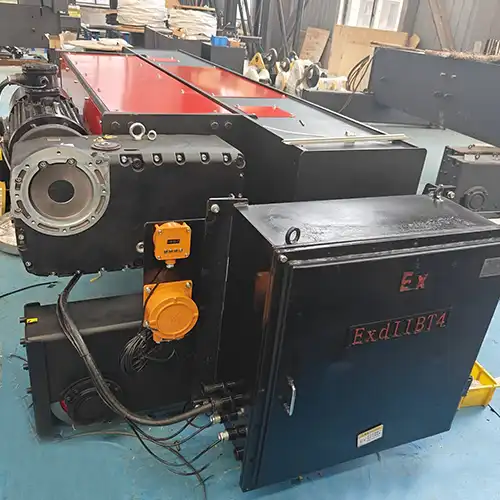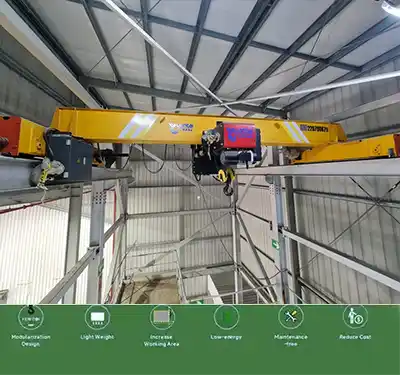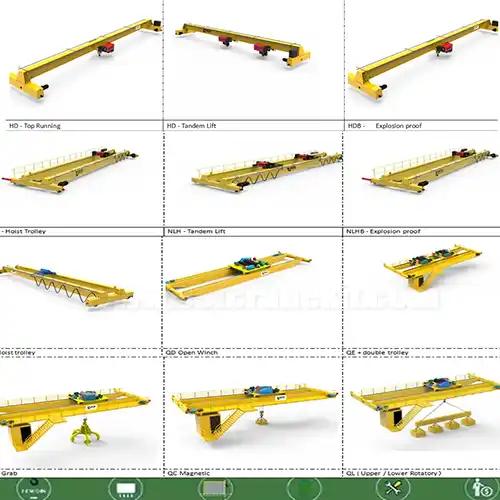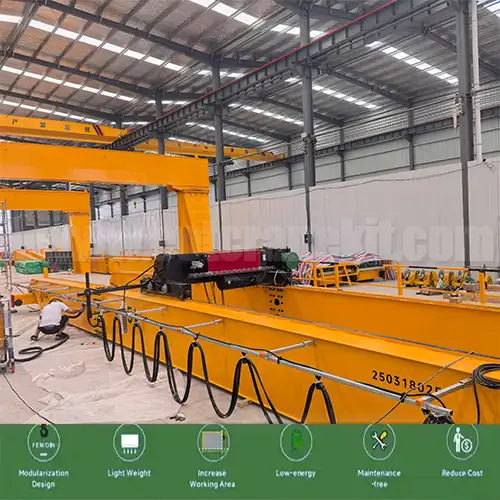Explosion-Proof Cranes for Jazan Refinery Plant, Saudi Arabia
Explosion-Proof Cranes for Jazan Refinery Plant, Saudi Arabia, Tailored Explosion Proof Overhead Cranes Ensuring Safe Lifting in Hazardous Environments!
Category: Saudi Arabia
Your Trusted Explosion Proof Crane Manufacturer & Supplier
Explosion-Proof Cranes for Jazan Refinery Plant, Saudi Arabia
Explosion Proof Overhead Cranes Ensuring Safe Lifting in Hazardous Environments
Introduction: Industrial Growth and Safety Demands in Jazan, Saudi Arabia
The Jazan Refinery Complex, located in the southwest of Saudi Arabia, is a vital part of the Kingdom’s energy and industrial expansion plan under Vision 2030. This massive site is not just another refinery—it plays a central role in boosting Saudi Arabia’s downstream capabilities and creating job opportunities in the region.
This facility processes hundreds of thousands of barrels of crude oil daily and supports related petrochemical and power generation operations. As you can imagine, it’s a high-risk environment. Hydrogen, sulfur, gas, and other flammable chemicals are handled here every day, which means safety isn't just a requirement—it’s a lifeline.
Explosion-proof cranes are a must-have for this kind of environment. They’re not only built to handle heavy loads, but also designed to work without creating sparks or heat that could trigger an explosion. And in Jazan, where the temperature often climbs above 45°C and dust can clog anything not properly sealed, the equipment must be up to the task.
Why Safety and Lifting Go Hand in Hand in Jazan
- Hydrogen-rich processing zones require lifting systems that won’t trigger combustion.
- Flammable vapors and gases are constantly present in many parts of the plant.
- Dust, salt, and high heat create harsh working conditions for standard equipment.
- Saudi regulations and Aramco standards strictly enforce the use of certified explosion-proof lifting equipment in Zone 1 and Zone 2 hazardous areas.
- Routine maintenance on valves, motors, and process equipment demands regular overhead lifting—there’s no room for unsafe or uncertified cranes.
So, if you're supplying, installing, or managing lifting equipment in a refinery like Jazan's, it’s not enough for the crane to just do the job—it has to do it without causing danger, downtime, or compliance headaches. That’s where explosion-proof cranes come into play.
What Makes a Crane Explosion-Proof?
When people hear “explosion-proof,” they often imagine a crane that can survive a blast. That’s not quite it. In reality, an explosion-proof crane is designed to prevent an explosion from ever happening in the first place. These cranes are built so that any electrical spark, heat, or arc generated during normal operation is fully contained and sealed off from the surrounding atmosphere.
This is critical in environments like refineries, where gases, vapors, and fine dust are part of the daily air. A single exposed contact, a hot motor, or a faulty brake resistor could be all it takes to set off a disaster. That’s why the materials, motor enclosures, wiring systems, and even control panels are specifically designed for hazardous zones.
How Explosion-Proof Cranes Are Built for Hazardous Zones:
- Enclosed motors that won’t ignite gas or vapor even under load or heat.
- Flameproof wiring and sealed junction boxes to prevent arc exposure.
- Non-sparking brakes and limit switches designed to operate safely inside hazardous environments.
- Intrinsically safe control systems that can be used in explosive atmospheres.
These aren’t just features—they’re requirements when you’re lifting equipment in places like hydrogen plants or gas separation units.
Applications of Explosion-Proof Cranes in Jazan's Refinery Facilities
In a refinery like Jazan's, lifting isn't an occasional task—it's part of the daily workflow. From heavy equipment changes to routine servicing of pumps and valves, overhead lifting systems are constantly in use. But with hazardous gases in the air and extreme heat as the norm, only explosion-proof cranes are safe enough to be used in these environments.
Pump Station and Injection Pump Maintenance
These are high-risk areas with constant fluid and gas movement. Cranes are often needed to lift heavy pumps for repair or replacement.
- Explosion-proof hoists ensure no sparks are released during sudden stops.
- Motors must be sealed to avoid heat buildup that could ignite leaking vapors.
- Local control panels need to be ATEX/IECEx rated for Zone 1 or 2 use.
Reactor Units and Hydrogen Processing Areas
Hydrogen is highly explosive and leaks easily. Reactors are also often located in hot, enclosed spaces.
- Only Zone 1-rated equipment is suitable.
- Lifting operations here include handling large filters, vessel covers, and internal components.
- Cranes must operate quietly, without friction points that generate heat.
Tank Area Lifting and Barrel Movement
Large chemical or fuel storage tanks are located outdoors in open fields. Movement of drums, barrels, or valves happens frequently during loading or cleaning.
- Explosion-proof gantry cranes or jib cranes are typically installed for outdoor use.
- Dust-proof, corrosion-resistant coatings are essential in coastal Jazan conditions.
- Barrel clamps and anti-spark lifting hooks are often used to improve safety.
Gas Recovery Units and Sulfur Treatment Zones
These areas produce and handle sulfur compounds and combustible gases. They are strictly classified as hazardous.
- Cranes here are used to lift gas compressors, piping modules, and access equipment.
- Remote control operation is preferred to keep workers at a safe distance.
- Equipment should have built-in overload protection and emergency shutdown functions.
Explosion-proof cranes in these applications aren't just about lifting—they're about preventing the kind of incidents that can shut down an entire facility or, worse, cause harm. That's why they're a core part of the refinery's safety infrastructure in Jazan.
Common Explosion-Proof Crane Types Used in Saudi Refineries
Refinery operations across Saudi Arabia—including Jazan—rely on a mix of crane types to handle different lifting needs safely in hazardous environments. Whether it's for regular maintenance, equipment replacement, or part of daily operations, the right crane type must match the job location, lifting capacity, and explosion protection zone.
Double Girder Overhead Cranes
These are the workhorses of refinery workshops. They're designed for handling heavy equipment, large pump assemblies, and motor blocks inside process and maintenance buildings.
- Suitable for Zone 1 and Zone 2 classified indoor areas
- Offers higher lifting height and longer spans compared to single girder types
- Often fitted with explosion-proof electric wire rope hoists
- Supports twin hoist systems for safer, balanced handling of long loads
Specifications of Double Girder Overhead Crane
These cranes are designed for heavier lifting tasks and are commonly installed in main maintenance workshops or large process buildings.
- Common Capacity Range: 10 to 50 tons
- Span Range: 10 to 28 meters
- Lift Height: 6 to 20 meters
- Typical Uses: Removing or replacing compressors, turbines, or large valves during maintenance shutdowns or equipment overhauls.
Single Girder Overhead Cranes
Not every lift requires a massive structure. Single girder overhead cranes are ideal for light to medium-duty lifting where ceiling height is limited.
- More economical and easier to install than double girder cranes
- Commonly used in maintenance bays, smaller workshops, or auxiliary areas
- Still certified for Zone 1 or Zone 2 operation
- Lifting capacity usually ranges from 1 to 10 tons
Specifications of Single Girder Overhead Crane
Used in smaller facilities or auxiliary buildings where heavy loads are less frequent but still require safe lifting.
- Common Capacity Range: 1 to 20 tons
- Span Range: 6 to 20 meters
- Lift Height: 4 to 12 meters
- Typical Uses: Handling tools, small motors, or parts inside electrical, instrumentation, or packaging areas.
Explosion-Proof Gantry Cranes
For lifting tasks in open refinery fields, gantry cranes are the go-to solution. These are especially helpful in tank farms, pipe rack areas, or temporary work zones.
- Can be rail-mounted or rubber-tired for flexibility
- No need for a building or crane runway
- Designed with outdoor-rated explosion-proof hoists and motors
- Coated to resist salt air and desert sand, ideal for coastal locations like Jazan
Specifications of Explosion-Proof Gantry Crane
Commonly used outdoors or in semi-open zones such as tank farms or pipe racks.
- Common Capacity Range: 10 to 30 tons
- Span Range: 8 to 20 meters
- Lift Height: 6 to 12 meters
- Typical Uses: Drum handling, pipe loading, and general maintenance work in exposed refinery areas.
Wall-Mounted and Column-Mounted Jib Cranes
These are practical for localized lifting, such as removing pumps, adjusting valves, or loading small components.
- Installed near machinery, columns, or building walls
- Rotation options of 180° to 360° depending on mounting style
- Used in tight spaces where a full overhead crane isn't practical
- Typically paired with small explosion-proof chain hoists
Specifications ofJib Crane (Wall-Mounted or Column-Mounted)
A space-saving solution for local lifting near equipment or workstations.
- Common Capacity Range: 0.5 to 5 tons
- Arm Length (Span): Up to 6 meters
- Lift Height: 3 to 6 meters
- Typical Uses: Removing pumps, adjusting valves, or lifting gearboxes in tight zones.
These are the lifting core of most explosion-proof cranes, especially where space is limited or integration into existing beams is needed.
- Available in capacities from 1 to 20 tons or more
- Used in both new crane systems and retrofit upgrades
- Features flameproof motors, sealed control cabinets, and spark-resistant hooks
- Supports wireless remote control for safer, hands-free operation in hazardous areas
Specifications of Explosion-Proof Electric Hoist (Wire Rope or Chain Type)
These are often integrated into existing crane girders or beam tracks and are the heart of most explosion-proof lifting systems.
- Common Capacity Range: 1 to 20 tons
- Span: Not applicable (depends on the supporting structure)
- Lift Height: Up to 12 meters
- Typical Uses: Compact lifting systems, monorail setups, or mobile workstations where flexibility and compliance are needed.
Each of these crane types has a specific role in refinery lifting operations. Selecting the right one depends on where it's being used, what it's lifting, and how often. In Jazan and other refinery hubs across Saudi Arabia, that choice starts with one simple rule: if it's a hazardous zone, it must be explosion-proof—no shortcuts.
Each lifting application in a refinery has its own challenges—whether it’s limited headroom, outdoor exposure, or the risk of explosive gases. The capacity and range of each crane type must match the environment and lifting frequency while meeting all applicable explosion-proof requirements. This ensures both operational efficiency and safety compliance across every part of the refinery.
| Crane Type | Common Capacity Range | Span Range | Lift Height |
|---|---|---|---|
| Double Girder Overhead Crane | 10–50 tons | 10–28 meters | 6–20 meters |
| Single Girder Overhead Crane | 1–20 tons | 6–20 meters | 4–12 meters |
| Gantry Crane | 10–30 tons | 8–20 meters | 6–12 meters |
| Jib Crane | 0.5–5 tons | Arm up to 6 meters | 3–6 meters |
| Explosion-Proof Hoist | 1–20 tons | N/A | Up to 12 meters |
Key Explosion-Proof Features for Saudi Arabian Environments
Explosion-proof cranes installed in Saudi Arabia, especially in areas like Jazan, need to do more than just meet hazardous zone ratings—they also have to withstand some of the toughest environmental conditions found in the Gulf region. Extreme heat, high humidity, corrosive air, and fine dust are part of daily life. Equipment failure isn't just inconvenient here—it can be dangerous. To ensure reliable operation and long service life, explosion-proof cranes in Saudi environments are engineered with a specific set of features tailored to the region's climate and industrial needs.
Flameproof Motors
Standard motors won't last long under Saudi summer conditions. That's why explosion-proof motors used in refinery cranes are built to tolerate high surface temperatures.
- Rated for ambient temperatures above 50°C
- Special winding insulation prevents overheating
- Housing designed to contain internal ignition without external risk
Enclosed Copper-Free Aluminum Housing
Corrosion is a serious issue near the coast, and Jazan sits right on the Red Sea. Moisture and salt air can eat through unprotected steel quickly.
- Copper-free aluminum resists pitting and corrosion
- All enclosures for electrical components are sealed and weather-resistant
- Reduces maintenance frequency and extends lifespan in humid and marine conditions
Flameproof Limit Switches and Control Panels
Critical for safe lifting operations, these devices stop the crane or hoist when it reaches a set limit. But in a hazardous zone, even these components must be sealed.
- Certified for use in Zone 1 and Zone 2 environments
- Fully enclosed to prevent sparks from reaching outside air
- Designed to keep functioning even in dusty or corrosive atmospheres
Explosion-Proof Remote Controls for Zone 1/Zone 2
Manual push-button stations are risky in some cases, especially in exposed areas. Remote controls give operators distance and safety.
- Wireless systems designed for use in classified areas
- Intrinsically safe and housed in flameproof casings
- Allows lifting from a safe distance, especially during maintenance or gas releases
Dust-Proof and Sand-Resistant Design
Refineries located near deserts or coastlines must deal with windblown sand, fine dust, and occasional salt storms. These elements can clog filters, damage motors, and reduce system reliability.
- All bearings, seals, and enclosures are protected against particle ingress
- Fans and vents are filtered or sealed to prevent sand intrusion
- Surface coatings resist abrasion and UV damage
Crane systems in Jazan's refinery—and throughout Saudi Arabia—can't afford to take shortcuts on environmental protection. These features aren't just technical specifications; they're real safeguards that keep lifting systems running safely and consistently under extreme local conditions.
Compliances Required in Saudi Arabia
If you’re working with or supplying cranes in Jazan—or anywhere in the Kingdom—certification is not a choice. It’s mandatory. Saudi Arabia follows strict compliance standards for explosive atmospheres, especially when working with Saudi Aramco or other major industrial operators.
Key Certifications and Standards to Know:
IECEx and ATEX Certification
- These international standards confirm that equipment is safe for explosive gas and dust environments.
- Equipment must be marked for the appropriate zones (e.g., Zone 1, Zone 2).
Saudi Aramco Engineering Standards (SAES)
- Aramco requires all lifting equipment installed in hazardous areas to be certified and documented.
- Third-party inspection and FAT (Factory Acceptance Test) reports are often required before delivery.
NEC/CEC Class I, Division 1 & 2 (for North American-standard components)
- Occasionally used if equipment is sourced from the U.S. or Canada.
- Defines electrical safety based on the presence and duration of explosive gases.
When selecting or supplying a crane for use in Saudi Arabia’s refinery zones, it’s not enough to ask “is it explosion-proof?” The better question is—“Does it meet the exact zone rating, ambient condition, and local approval requirements?” If the answer isn’t yes, the crane doesn’t belong in a hazardous zone.
Why Saudi Buyers Should Source Certified Suppliers
When it comes to explosion-proof cranes for Saudi Arabia’s critical industries—like refineries in Jazan—buying from certified, trusted suppliers is more than just good practice. It’s a necessity. The standards here are strict, and for good reason: these cranes operate in some of the most hazardous environments on the planet.
Compliance with Local and Industry Standards
Saudi Aramco, SABIC, and the Royal Commission for Jubail and Yanbu have their own detailed project standards. Any lifting equipment used in their facilities must meet these requirements to ensure safety and reliability. Non-compliance can lead to rejected deliveries, costly delays, and even project shutdowns.
What to Look for in a Supplier:
- Third-Party Inspection Reports: Independent verification shows the crane meets all technical and safety standards before shipping. This builds confidence that the equipment will perform as promised.
- On-Site Installation Guidance: Proper installation is critical for explosion-proof cranes. A supplier that offers expert supervision ensures everything is done correctly, minimizing risks and rework.
- After-Sales Service Within Saudi Arabia: Fast access to parts and service technicians means less downtime if something needs repair or maintenance. Local support is invaluable, especially for complex cranes in hazardous zones.
Long-Term Benefits of Choosing Certified Suppliers
While certified cranes might come with a higher upfront cost, they usually save money over time by reducing safety incidents and unplanned shutdowns. Reliable cranes mean fewer disruptions to production and a safer working environment for everyone involved.
Conclusion: Investing in Safety and Reliability
In Saudi Arabia’s refineries—especially in critical hubs like Jazan—explosion-proof cranes are not just an optional extra. They are mission-critical equipment that ensures the safety of personnel, protects expensive assets, and keeps operations running smoothly.
Refineries deal with flammable gases, volatile liquids, and combustible dusts every day. One mistake or substandard lifting tool can lead to serious accidents, costly shutdowns, or worse. That’s why investing in the right explosion-proof crane is an investment in the plant’s overall safety culture and operational reliability.
Why Safety and Reliability Should Drive Crane Selection
- Protecting People and Assets: Explosion-proof cranes prevent ignition sources in hazardous zones, significantly reducing the risk of fires or explosions. This protection is crucial for workers and the facility’s infrastructure alike.
- Compliance with Regulations: Saudi Arabian industrial safety authorities, along with corporate standards like Saudi Aramco’s, require strict adherence to explosion-proof equipment standards. Using certified cranes ensures smooth project approvals and inspections.
- Minimizing Downtime: Reliable cranes that can withstand harsh desert heat, coastal humidity, and dust minimize unexpected failures and emergency repairs, keeping production on schedule.
- Long-Term Cost Savings: While explosion-proof cranes may cost more initially, their durability, fewer maintenance demands, and compliance with local and international codes result in lower total cost of ownership.
Tailored Solutions for Saudi Conditions
Choosing cranes designed specifically for Saudi Arabia’s environment—such as motors rated for extreme heat and corrosion-resistant materials—is essential. Additionally, cranes must be certified to meet both international explosion-proof standards (IECEx, ATEX) and Saudi-specific requirements (SAES). This combination guarantees that the equipment is built not only for safety but also for the unique operating challenges faced in Saudi refineries.
In short, explosion-proof cranes are a foundational part of refinery infrastructure. For plants in Jazan and across the Kingdom, investing in certified, locally suitable, and durable cranes means investing in a safer workplace, regulatory peace of mind, and uninterrupted operations. It’s not just smart—it’s essential.
Related Products
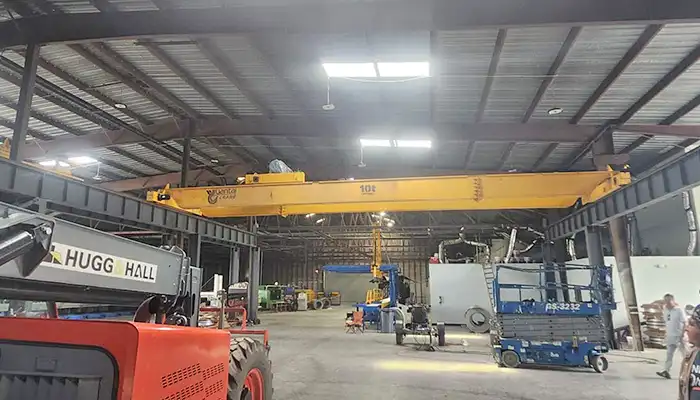
Affordable 10 ton double girder overhead crane with CD/MD hoist trolley, built for U.S. standards, ideal for construction and industrial lifting
Free consultation to Confirm Parameters & Specifications and Get
Latest Crane Price & Crane Rate.
- Types of overhead cranes : _______?
- Optional: Overhead travelling crane, goliath gantry crane,Slewing jib crane, Single girder or double girder crane,small portable crane or kbk crane, etc.
- Capacity of overhead crane: _______?
- Optional: 0.25ton, 0.5 ton, 1 ton, 2 ton, 3ton, 5 ton, 10 ton,15ton, 20ton, 25 ton, 30ton,35ton, up to 550ton, etc.
- Crane span & lifting height : _______?
- Crane travelling length : _____?
- Control of overhead crane:_______?
- Optional: pendant/ remote/cabin control
- Voltage supply of overhead crane:_____?
- Eg,: 380V50/60HZ,3Phase or others,etc.
- Application/usage of crane:_______?
- Eg,: Steel mill, ,injection mold, cement,stone, concrete,granite, general manufacturing, etc.
Just leave a message via the contact form and our hoist and crane engineer will contact you with in 24working hours.
Get In Touch
